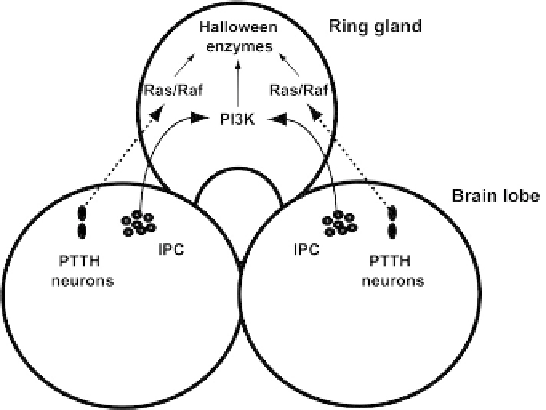Biology Reference
In-Depth Information
Figure 3.41
The regulation of ecdysone synthesis by insulin and PTTH. Brain lobes and the
ring gland are indicated. Ecdysone synthesis is triggered when insulin released from the IPCs
and PTTH released from the PTTH neurons activate the PI3K and Ras pathways, respectively,
in the prothoracic gland. These two pathways, acting together, activate transcription of the
PG-specific “Halloween genes,” which encode the ecdysone biosynthetic enzymes, ultimately
triggering ecdysone synthesis. Arrows indicate activation pathways for which there is
experimental evidence in
Drosophila
; the hatched arrow indicates a speculative activation
pathway.
Source
: From Walkiewicz and Stern (2009).
The
Drosophila
nervous system responds to developmental disturbances, such as
damages to imaginal disks, by postponing pupariation time to allow for regeneration
to take place. Recently, it has been demonstrated that the CNS may use information
on the increased secretion of the hormone peptide DILP8 by imaginal disks as a cue
indicating growth status (
Garelli et al., 2012
) and the dose-dependent postponement
of the growth and pupariation.
In the freshwater snail
Lymnaea stagnalis
, insulin-like neuropeptides control body
growth. The snail's brain has about 200 giant neurons known as light green cells
(LGCs), which produce four types of insulin-like neuropeptides that are transported
to axon terminals and released to a neurohemal-like area. The cauterization of these
giant neurons causes marked body growth retardation in juvenile, rapidly growing
snails. Each of the lateral lobes of the brain contains an ectopic LGC connected to
axons of giant neurons and has an inhibitory effect on body growth, as shown by the
fact that their cauterization leads to the development of giant snails (
Geraerts, 1976;
Smit et al., 1998
).
The neural control of body weight is also observed in lower animals such as
planarians, where the adult animal size and tissue homeostasis are regulated by the
neurally secreted, insulin-like neuropeptide Ilp-1. Disrupting the insulin signaling in

Search WWH ::

Custom Search